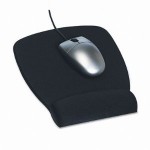by Katie Grosteffon, AEP
One pervasive “ergonomic” desk accessory is the mouse pad with an elevated wrist rest. People like these because they can rest their wrists on the gel instead of the hard desk. Here are a couple reasons why I am hesitant to recommend one of these items:
1. Wrist compression
When you rest on your wrist, you can compress the blood vessels, tendons, and nerves that travel through your wrist. But you may ask “isn’t it better to rest on the gel than on a hard desk?”. Not necessarily, because often the wrist rest padding is quite stiff, and the presence of the rest makes users think it is good to rest their wrist, so they tend to rest them more often. Resting your wrist for too long can potentially cause inflamed tendons and nerve entrapment.
Solution: Change your desk height (if possible) or your chair height so that your desk is the same height as your elbows. Also, if your desk has an adjustable angle, make sure it is flat or slightly tilted away from you (never toward you). These adjustments help keep your wrist straight while you are using the mouse.
2. Improper mouse movement
In order to reduce the risk of injury and discomfort, the proper way to move the mouse is with whole arm movements that originate at the shoulder. But an elevated wrist rest can get in the way of this. If you try to move your arm, your wrist drags across the wrist rest, so you cannot move the mouse efficiently. Instead, you plant your wrist and control your mouse with small wrist movements.
Solution: Eliminating the use of the wrist rest and moving to an alternative mouse will position the wrist away from the desk and reduce the chance of causing discomfort and pain. Look for a mouse that is designed to keep your wrist off of the desk, preventing compression. Options include larger mice, which support your whole hand so you are not resting on the desk surface, and angled mice, which rotate your wrist (up to 90°) so that you are resting on bone instead of the soft palmar side of your wrist.
Need more help with office ergonomics? Learn about VelocityEHS Ergonomics software.
